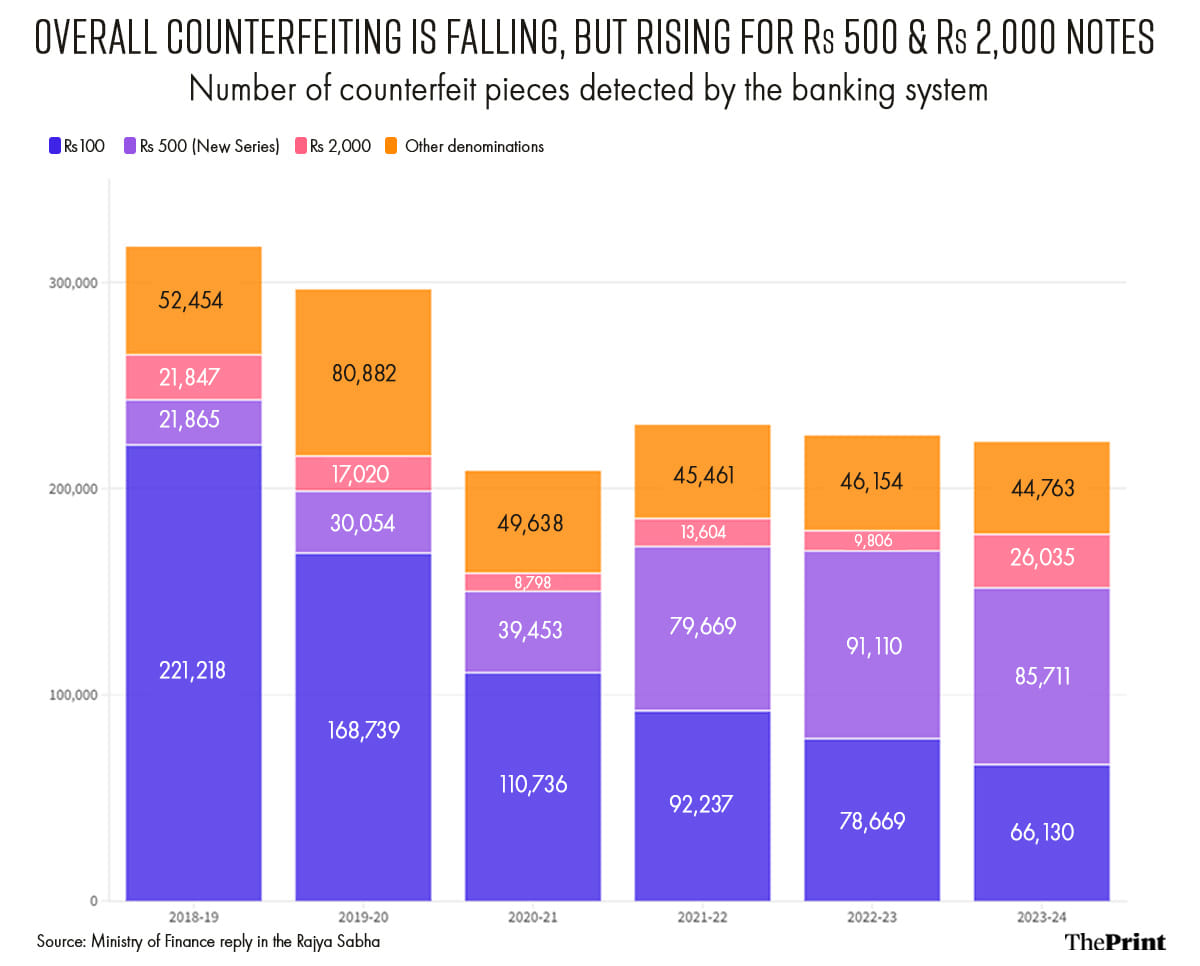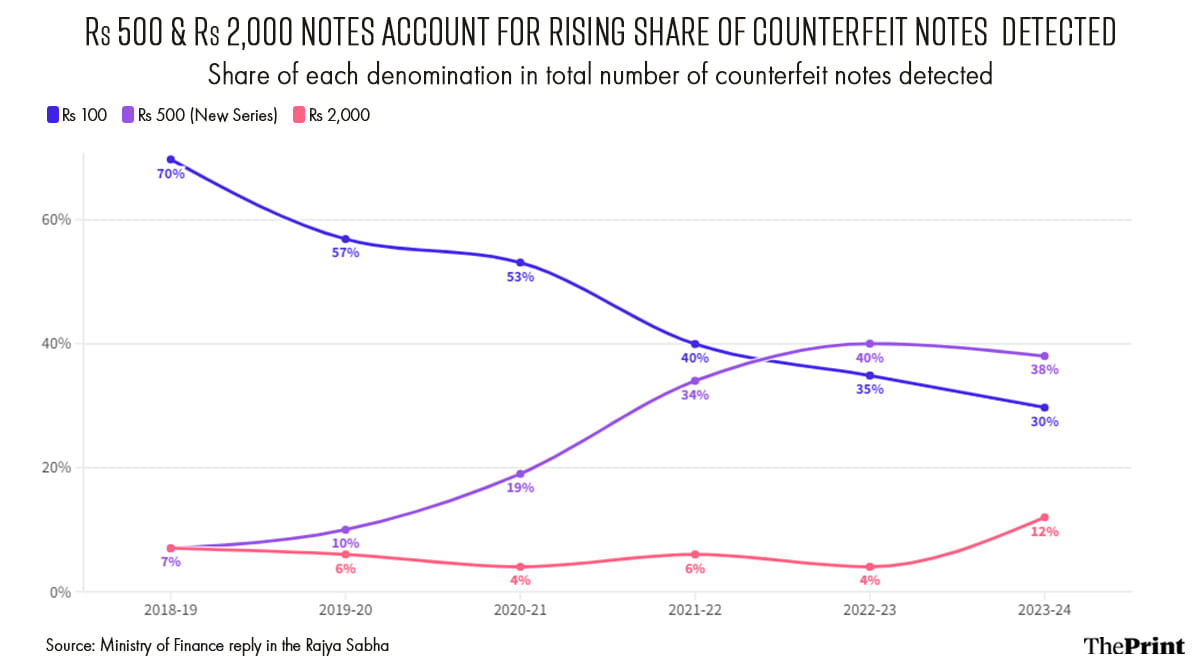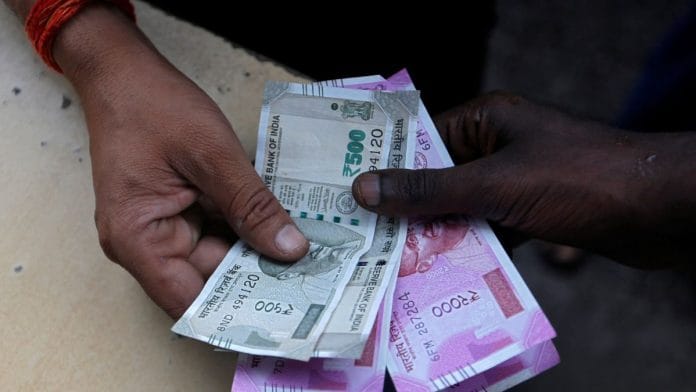New Delhi: The new series of the Rs 500 note and the Rs 2,000 note — both introduced after demonetisation in 2016 — together account for just over 50 percent of the number of counterfeit currency notes that have been detected, according to data submitted to Parliament by the government.
Notably, the number of counterfeit Rs 500 notes of the new series that have been detected has nearly quadrupled between 2018-19 and 2023-24, while the number of fake Rs 2,000 notes has seen a more recent jump — nearly tripling since 2022-23.
This is especially significant because one of the stated aims behind the demonetisation exercise and the release of new variants of the bank notes was to reduce counterfeiting.
According to the data submitted by the Ministry of Finance to the Rajya Sabha in response to a question, the total number of counterfeit notes detected or seized by the banking system has fallen over the years — from 3.2 lakh notes in 2018-19 to 2.2 lakh notes in 2023-24.

“The measures (to reduce counterfeiting) have resulted in a decrease in the number of pieces of denomination-wise counterfeit notes detected/reported in the banking system from 3,17,384 in the year 2018-19 to 2,22,639 in the year 2023-24,” Minister of State for Finance Pankaj Chaudhary said in his reply.
“Government in consultation with its various agencies and Reserve Bank of India takes necessary steps to curtail the use and circulation of fake currency in the country from time to time,” he added. “New security features are also introduced in Indian banknotes from time to time to enhance their anti-counterfeiting properties.”
Also Read: Advantage Adani or pressure on Bangladesh? India’s new power export rules could achieve both
More high value fake notes

However, the data shows that the reduction in the number of counterfeit notes detected has been driven by the fall in counterfeit Rs 100 notes, while the numbers of fake Rs 500 and Rs 2,000 notes detected has increased substantially.
The Rs 100 note was by far the most counterfeited in 2018-19, with 2.2 lakh pieces being detected as fake, accounting for nearly 70 percent of all fake notes detected that year. This has since fallen drastically, both in terms of absolute numbers and share in total counterfeited notes. Fake Rs 100 notes, numbered at 66,130 in 2023-24, accounted for just 30 percent of the total fake notes detected that year.
On the other hand, the new Rs 500 note — introduced in 2016 to replace the demonetised series — has seen an increasing incidence of counterfeiting. The number of these counterfeit notes increased from 21,865 in 2018-19 to 85,711 in 2023-24, nearly quadrupling.
The share of the new series of Rs 500 note in the overall number of fake notes detected every year increased from 6.9 percent to 38.5 percent over this period.
The now-discontinued Rs 2,000 note, also introduced post-demonetisation, saw a decline in counterfeiting between 2018-19 and 2022-23 — from 21,847 fake pieces to 9,806 fakes — before again seeing a surge to 26,035 fake pieces detected in 2023-24.
Fake Rs 2,000 notes made up nearly 12 percent of all counterfeit notes detected in 2023-24, up from a little more than 4 percent just a year before.
Key aim of demonetisation still elusive
These findings show that one of the aims of demonetisation — reducing counterfeiting — has not been achieved.
“Government of India in consultation with RBI has withdrawn legal tender character of banknotes in the denomination of Rs 500 and Rs 1,000 issued till November 8, 2016, inter alia, to reduce the incidence of fake Indian currency notes,” Chaudhary informed the Rajya Sabha.
Now, one argument for the increase in the detection of fake Rs 500 and Rs 2,000 notes could be that the security measures on these notes are working and that the fakes are being caught more effectively.
However, this does not then answer why the total number of counterfeits has fallen. That is, if the government is getting better at catching fakes, then it should be finding more not less. On the other hand, if overall counterfeiting is falling, the question then is why it is increasing for Rs 500 and Rs 2,000 notes in particular.
These issues are of particular note because according to Chaudhary’s answer, RBI has issued new series of not just Rs 2,000 and Rs 500 denominations, but also for Rs 200, Rs 100, Rs 50, Rs 20 and Rs 10 — all of which have enhanced anti-counterfeiting features.
(Edited by Mannat Chugh)
Also Read: Why India’s digital banking push is giving RBI nightmares. Hint: The Credit Suisse collapse






